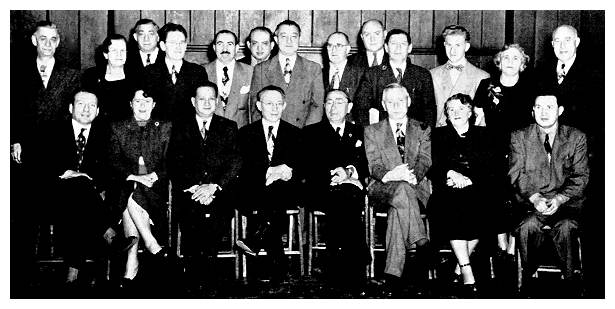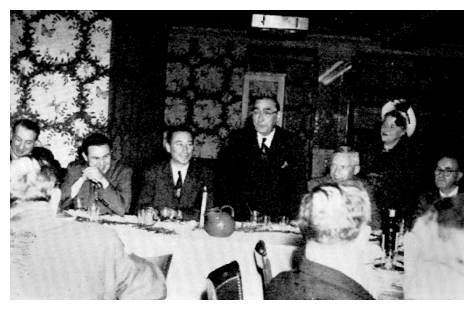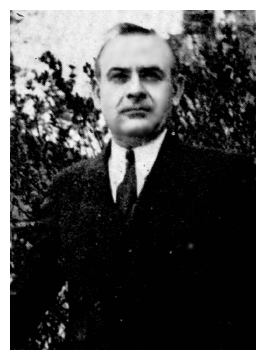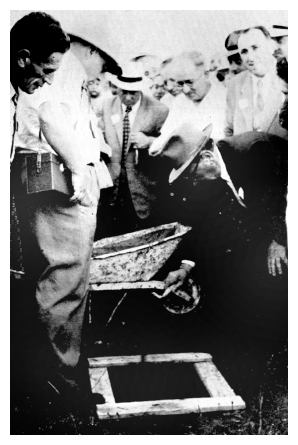[Pages 182-85]
Relief Work and Shikkun Brzezin
(Brzeziner Housing Project) in Israel
by Nathan Summer and Fishel Maliniak
Translated by Renee Miller
Edited by Fay Bussgang
When we now record the history of our relief work and want to analyze how it was possible for us to successfully carry out such a project, we can only characterize it as an episode in the history of Brzeziners in America that, in its scope, had no equal, not only among our landslayt [fellow townsmen], but also among other similar organizations in the country.
We should not forget that the period 1945–56 was a very intense time in the lives of the American Jewish community. It was the time of the United Jewish Appeal—preparation for the rise of the Yidishe medine [Jewish land] in Eretz Isroel [Land of Israel], and from all sides came urgent appeals for help and monetary support. Nevertheless, a small group of Brzeziners succeeded in collecting over $50,000, which was in addition to other donations Brzeziners had made to national institutions, as well as their contributions to the general Jewish community life in America, both as individuals and as an organization.
In order to understand this, one must place oneself in that time period, into that terrible emotional frame of mind in which American Jews were living. On the one hand, there had been the destruction of all the cities and shtetlekh [small towns], which most of the still-living community in America had once called home; and on the other hand, was the arrival of salvation—one could see with one's own eyes the rise of Medines Isroel.
And when you add to this the personal element of finding a relative or a friend—and, in most cases, the only rescued relative from thousands of family members who had been annihilated—one can understand the willingness for self-sacrifice displayed by various individuals among us in America.
|
|
The Brzeziner Relief Committee
Sitting from right to left: Abraham Rosenberg, Rachel Bergman, Joseph Diamond, J. D. Berg, Morris
Hendricks, Louie Horn, e”h [may he rest in peace], Fannie Tanenbaum, and Fishel Maliniak.
Standing from right to left: Sam Hyman, Masha Green, N. Summer, Izzy Schilsky, Joseph Shaibowicz,
Max Tushinsky (Tyson), Sam Fox. Harry Peters, e”h, Willie Rosenfeld, Feiwel Rosenberg, e”h,
Alter Rosenfeld, e”h, Gussie Pakula, and S. Fuks.
(Missing in the picture were, among others, Aron Selin, J. Rosenblum, Meyer Lasky, Rene Lasky,
Louie Hauser, Shlomo Schwartz, Sam Maliniak, Jehuda Fuks, and Manny Snyder.)[1]
|
|
|
A meeting, on behalf of refugee landslayt, of the well-known union leader
Sasha Zimmerman with representatives of the Brzeziner Relief Committee
From right to left: Max Tushinsky, Rachel Bergman, Joseph Diamond, J. D. Berg
addressing the people, Sasha Zimmerman, A. Rozenberg, and Fishel Maliniak
|
Therefore, we can ascribe the success of our work not just to the leaders of the Relief Committee, without whom nothing would have been accomplished, but, most of all, to the aroused compassion of our landlayt.
A second factor was the organization of the project. Although the entire project was carried out on a voluntary basis, the plans for the work were prepared in great detail, and the meetings and general conferences were well planned. The people who were at the head of the committee had enormous experience in organizing Jewish life, not only in America, but also in Europe. For instance, the chairman was Brother Jacob David Berg, president of the Sholem Aleichem Folk Institute for many years, while the vice-president, Brother Joe Diamond, was an active trade union leader. The situation was the same with Brother Louie Horn—after the death of Brother Willie Green, who was an intelligent person and had been a businessman. The secretary, Brother Fishel Maliniak, came to America in 1941 with long years of experience in administrative leadership at the headquarters of the Hebrew-language school system in Poland—the Tarbut Center in Warsaw. In addition, the following were also members of the committee—Jehuda Fuks and Louie Hauser. And we were fortunate to have among us the capable, energetic Ruth Hauser, who took over the work from Louie Horn when he left us so suddenly. As can be seen, the best people that the landsmanshaft [society of fellow townsmen] in New York possessed were placed at the head of the committee.
And now, a history of our project. Immediately at the outbreak of World War II, in 1939, the leaders of the Brzeziner Society created a committee dedicated to the collection of special funds for the needy among Brzeziner Jews. At that time we hoped, first of all, that the war would not last long and, second, that Jews here would be willing to help as long as the war continued. Members of the Society, members of the Ladies' Auxiliary, and respected landslayt whose participation lent dignity to the committee were represented on that committee.
However, it soon became clear that the committee could accomplish very little and that this war was different from World War I. Therefore, the committee discontinued its activities after a short time.
Then, at the beginning of 1945, when it appeared as if the war would end soon, an urgent meeting of the Society was covened to revive the committee.
|
|
Willie Green, e”h, former secretary
of the Relief Committee |
|
|
The laying of the cornerstone for
Shikhun Brzezin in Kfar-Unu, Israel
In the picture can be seen Jacob David Berg,
chairman of the Brzeziner Relief Committee
in America, Lemel Horn, Har-Jaffe (Szajnberg),
Abe Berg, and other landslayt. |
Translator's Footnote
- See footnote of previous chapter regarding names. Return
This material is made available by JewishGen, Inc.
and the Yizkor Book Project for the purpose of
fulfilling our
mission of disseminating information about the Holocaust and
destroyed Jewish communities.
This material may not be copied,
sold or bartered without JewishGen, Inc.'s permission. Rights may be
reserved by the copyright holder.
JewishGen, Inc. makes no representations regarding the accuracy of
the translation. The reader may wish to refer to the original material
for verification.
JewishGen is not responsible for inaccuracies or omissions in the original work and cannot rewrite or edit the text to correct inaccuracies and/or omissions.
Our mission is to produce a translation of the original work and we cannot verify the accuracy of statements or alter facts cited.
 Brzeziny, Poland
Brzeziny, Poland
 Yizkor Book Project
Yizkor Book Project
 JewishGen Home Page
JewishGen Home Page
Yizkor Book Director, Lance Ackerfeld
This web page created by Lance Ackerfeld
Copyright © 1999-2026 by JewishGen, Inc.
Updated 30 Jan 2010 by LA






